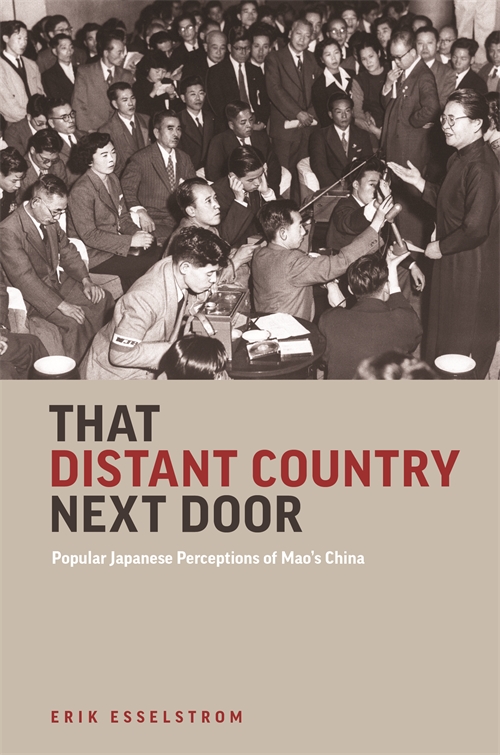That Distant Country Next Door: Popular Japanese Perceptions of Mao’s China
- About the Book
-
Japan’s road to war in China in the 1930s–1940s is well known, as are the legacies of that conflict in the diplomatic disputes, territorial rows, and educational policy battles between Japan and China since the 1980s. Less understood is the nature of Japan-China relations in the intervening decades. How did a popular Japanese perception of China that facilitated imperial aggression become one that embraced restoring friendly diplomatic ties and cultivating mutually beneficial economic and cultural interactions? Exploring everyday Japanese impressions of the People’s Republic of China from the end of the U.S. Occupation in 1952 to normalization of Japan-China relations in 1972, this book analyzes representations of the PRC in Japanese print media and visual culture in connection with four topics: the 1954 visit to Japan by Minister of Health Li Dequan, China’s atomic weapons testing in 1964–1967, the Red Guard movement of the early Cultural Revolution years, and the culture of continental “rediscovery” in 1971–1972.
Japanese views of China under Mao were infused with elements of thematic and conceptual continuity linking the prewar, wartime, and postwar eras. In sketching out a portrait of these elements, Erik Esselstrom explains how the reconstruction of Japan’s relationship with China included more than just the trials and tribulations of Cold War diplomacy. In so doing, he reintegrates postwar Japan-China relations within the longer history of East Asian cultural interaction and engagement.
- About the Author(s)
-
Erik Esselstrom, Author
Erik Esselstrom is professor of Japanese and Chinese history at the University of Vermont.
- Reviews and Endorsements
-
- Taking issue with common wisdom about the wall between Japan and the PRC in the era of ‘containment,’ Erik Esselstrom offers a rich set of case studies that bring to light the interaction between the two countries from the 1950s through the 1970s. His account of Japan’s awareness of Mao’s Great Cultural Revolution is of particular importance, as we learn of the diversity of responses in the media and among intellectuals and the public—for example, Esselstrom offers a fascinating window into the dreams and frustrations of Japanese office workers who found the Cultural Revolution an inspiring outlet for expressing discontent with their own restricted lives during the high-growth era of the 1960s.
—Andrew Gordon, Harvard University - That Distant Country Next Door convincingly shows how different constituencies used China in different ways, often to forward their own political aspirations of what Japan should be. . . . Esselstrom’s work tells a fascinating story about how these conflicts over identity manifested themselves in postwar Japanese debates over China, despite the lack of official diplomatic relations. . . . The broad range of everyday sources inevitably means that we get a glimpse of the author’s sense of humor, and this only adds to the appeal of the book. It is a valuable addition to the literature of diplomatic history and East Asian political history.
—Shogo Suzuki, University of Manchester, The Journal of Japanese Studies, 47:1 (Winter 2021) - That Distant Country Next Door offers valuable insights into Japan-China relations from 1952 to 1972, a period when the Cold War and “containment” dominated bilateral relations. . . . Their bilateral relationship prior to 1972 has drawn less research interest beyond studies of official narratives. To fill this gap, Esselstrom offers a fascinating look into this forgotten period through his analysis of largely unexamined Japanese popular perceptions of China under Chairman Mao, from politicians, diplomats, industrialists, and intellectuals to students and salarymen and salarywomen, and he constructs the social and cultural context that was critical in facilitating the normalization.
—Jessica C. Liao, North Carolina State University, Raleigh, Pacific Affairs, 93:4, 2020 - [Esselstrom] uses his sources well to give nuanced descriptions of a broad range of perspectives about China. His book is a compact, reliable guide to Japanese perspectives at a critical juncture that shows us patterns of engagement that are still relevant today.
—Wesley Sasaki-Uemura, The University of Utah, The American Historical Review, 126:4 (December 2021)
- Taking issue with common wisdom about the wall between Japan and the PRC in the era of ‘containment,’ Erik Esselstrom offers a rich set of case studies that bring to light the interaction between the two countries from the 1950s through the 1970s. His account of Japan’s awareness of Mao’s Great Cultural Revolution is of particular importance, as we learn of the diversity of responses in the media and among intellectuals and the public—for example, Esselstrom offers a fascinating window into the dreams and frustrations of Japanese office workers who found the Cultural Revolution an inspiring outlet for expressing discontent with their own restricted lives during the high-growth era of the 1960s.
- Supporting Resources
-





